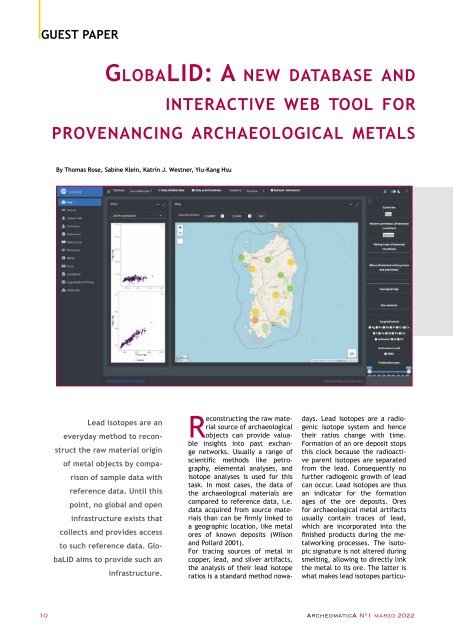Archeomatica_1_2022
GIGAPIXEL ALLA GALLERIA NAZIONALE DELL'UMBRIA
GIGAPIXEL ALLA GALLERIA NAZIONALE DELL'UMBRIA
Create successful ePaper yourself
Turn your PDF publications into a flip-book with our unique Google optimized e-Paper software.
GUEST PAPER<br />
GlobaLID: A new database and<br />
interactive web tool for<br />
provenancing archaeological metals<br />
By Thomas Rose, Sabine Klein, Katrin J. Westner, Yiu-Kang Hsu<br />
Lead isotopes are an<br />
everyday method to reconstruct<br />
the raw material origin<br />
of metal objects by comparison<br />
of sample data with<br />
reference data. Until this<br />
point, no global and open<br />
infrastructure exists that<br />
collects and provides access<br />
to such reference data. GlobaLID<br />
aims to provide such an<br />
infrastructure.<br />
Reconstructing the raw material<br />
source of archaeological<br />
objects can provide valuable<br />
insights into past exchange<br />
networks. Usually a range of<br />
scientific methods like petrography,<br />
elemental analyses, and<br />
isotope analyses is used for this<br />
task. In most cases, the data of<br />
the archaeological materials are<br />
compared to reference data, i.e.<br />
data acquired from source materials<br />
than can be firmly linked to<br />
a geographic location, like metal<br />
ores of known deposits (Wilson<br />
and Pollard 2001).<br />
For tracing sources of metal in<br />
copper, lead, and silver artifacts,<br />
the analysis of their lead isotope<br />
ratios is a standard method nowadays.<br />
Lead isotopes are a radiogenic<br />
isotope system and hence<br />
their ratios change with time.<br />
Formation of an ore deposit stops<br />
this clock because the radioactive<br />
parent isotopes are separated<br />
from the lead. Consequently no<br />
further radiogenic growth of lead<br />
can occur. Lead isotopes are thus<br />
an indicator for the formation<br />
ages of the ore deposits. Ores<br />
for archaeological metal artifacts<br />
usually contain traces of lead,<br />
which are incorporated into the<br />
finished products during the metalworking<br />
processes. The isotopic<br />
signature is not altered during<br />
smelting, allowing to directly link<br />
the metal to its ore. The latter is<br />
what makes lead isotopes particu-<br />
10 ArcheomaticA N°1 marzo <strong>2022</strong>


















